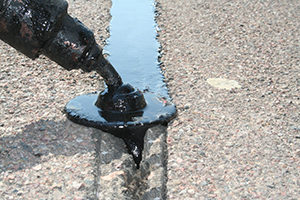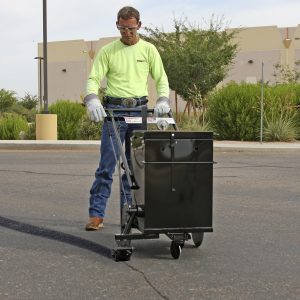what is the thickness of a crack to conver it into a control joint
In an independent written report, sealing cracks in pavement (crevice sealing) has proven to be the lowest toll pavement preservation treatment bachelor by far. In asphalt pavements, the side by side lowest toll pavement preservation treatment is a single flake seal which is approximately a whopping 4 times more expensive. Simply stated, a dollar spent crack sealing returns more do good than a dollar spent with other preservation treatments. If your goal is to preserve your pavement for the longest period at the lowest cost y'all must scissure seal.
Approximately 75% of cracks in asphalt pavement form into potholes inside iii years if they are not sealed. In drastic comparison, only approximately ane% of cracks that have been sealed volition form into potholes inside 3 years.
 Cracks are inevitable and are going to develop as the asphalt pavement continues to oxidize and deteriorate. However, crack sealing has been proven in studies to slow the rate of slap-up. In one study, after 2 years of ascertainment, 75% less cracking was observed in a pavement that was crack sealed in comparison to a pavement that received no treatment at all. Crack sealing tin can wearisome the rate of their formation in pavements over time.
Cracks are inevitable and are going to develop as the asphalt pavement continues to oxidize and deteriorate. However, crack sealing has been proven in studies to slow the rate of slap-up. In one study, after 2 years of ascertainment, 75% less cracking was observed in a pavement that was crack sealed in comparison to a pavement that received no treatment at all. Crack sealing tin can wearisome the rate of their formation in pavements over time.
Cleft sealing as a pretreatment improves the effectiveness of other surface treatments in cobblestone pavements. For example, a report showed that when crack sealing was completed every bit a pre-treatment to a scrap seal, 100% less nifty developed after 2 years of ascertainment in comparison to a chip seal only treatment. The chip seal only handling had already deteriorated back to be equivalent to the "control" pavement that had no treatment completed at all.
In some other example, crack sealing plus microsurfacing resulted in threescore% less bully vs. no treatment at year two. Microsurfacing alone resulted in but 15% less corking vs. no treatment at twelvemonth two. Again, crack sealing as a pretreatment improves other surface treatments.
If y'all want to go the most service life from your pavement, crack seal early and often!
- Pavement groovy is inevitable – information technology is going to happen
- Sealing cracks quickly after they develop reduces the impairment to the pavement
- The longer the cracks remains sealed, the longer the pavement volition perform
- Visually audit pavements every yr to identify and seal new cracks. Cracks greater than ane/8" (3 mm) must be sealed to achieve the best protection of the pavement.
- Visually audit previously sealed cracks every yr to identify failures and repair equally needed. If almanac inspection is not possible, previously sealed cracks should exist assessed every 3 years, the time it potentially takes for a crack to turn into a pothole.
What is the difference between Crack Sealing & Fissure Filling?
For simplicity, scissure sealing is generally installing crack sealant (specialized textile) which may or may non include a reservoir. Crack filling is more often than not installing crack filler (not-specialized fabric).
However, when information technology comes to conducting and post-obit the research, a better definition is needed. To reply the question, we start with a definition of terms. It is very important to understand these terms, and then we fully understand what inquiry has proven and how to employ the enquiry results to maximize your investment and achieve your pavement'south goals. Crack sealing and crack filling are oftentimes used interchangeably, but they are non interchangeable.
The four terms are:
- Scissure sealant (fabric)
- Cleft filler (cloth)
- Scissure sealing (process)
- Crack filling (procedure)
Scissure sealant:
- Is specialized material that bond to the walls of the scissure and can move horizontally and vertically with the pavement as it expands and contracts;
- Prevents intrusion of water and debris into the crack;
- Is specifically engineered to remain flexible at depression temperatures and so it does not fissure or split open and remains stable at higher temperatures then that it does not track or bleed on the pavement.
Examples of cleft sealant are Crafco Roadsaver, Polyflex and Asphalt Rubber hot-applied sealants.
Crack filler:
- Is ordinary textile that may bond to the walls of the scissure but cannot movement horizontally and vertically with the pavement as it expands and contracts;
- Reduces intrusion of water and debris into the crack;
- Is not specifically engineered to remain flexible at low temperatures and may not remain stable at higher temperatures.
 When pavement movement takes place due to temperature change or traffic loads, the crack filler is separated from the edge assuasive water and incompressible materials to enter the crack and into the pavement. Examples of crack filler are asphalt cements, liquid asphalt, cutback asphalts, or cobblestone emulsions that may be mixed with sand, which occasionally is referred to every bit 'oil and sand'.
When pavement movement takes place due to temperature change or traffic loads, the crack filler is separated from the edge assuasive water and incompressible materials to enter the crack and into the pavement. Examples of crack filler are asphalt cements, liquid asphalt, cutback asphalts, or cobblestone emulsions that may be mixed with sand, which occasionally is referred to every bit 'oil and sand'.
As you can encounter from the definitions, at that place are differences in the materials that are designed for unlike purposes – prevention vs reduction of infiltration is a significant difference. The process of installing these materials can also differ and have different outcomes.
Crevice sealant tin be installed into a reservoir and is often referred to every bit a crack sealing installation. When crack sealant (specialized material) is installed into a reservoir it can accept a variety of finishing techniques, and to name a few: (a) standard recessed band-aid, (b) shallow recessed ring-aid, and (c) standard reservoir and flush. Scissure sealant tin besides be installed without a reservoir and is often referred to as a 'blow and go' also known every bit 'crack filling' installation where the finishing technique is (a) capped or overband, or (b) elementary flush make full.
Crack filling as a process is idea of as a 'accident and become' awarding of crack sealant, as noted above. Yet, proceed in heed that cleft filler consists of dissimilar materials than crack sealant and is not placed in a reservoir with the same intent and purpose (prevention vs reduction of infiltration), and therefore you would not use a crack sealing installation using a reservoir for scissure filler products.
So, for a simple conclusion, fissure sealing is generally installing scissure sealant (specialized material) which may or may not include a reservoir. Crack filling is generally installing crack filler (not-specialized textile). Cleft sealant has been proven in independent studies to perform in asphalt pavement from ii to over 10 years depending on pavement status of poor to good, respectively. Crack sealant has proven to perform in physical up to 21 years. Crevice filler has proven generally to perform from ane to 2 years. Crack sealing is a long-term pavement preservation solution while crack filling is a band-aid. Pavement is always moving horizontally or vertically to some degree and therefore sealing is preferred over filling so that you can truly preserve the gigantic investment in our roads.
What type of solution do you demand for your crack sealing project?
There are a variety of fissure sealing solutions, and categorizing them tin be challenging. Generally there is hot-applied asphaltic-based cleft sealant and cold-applied scissure sealant. Cold-applied fissure sealant should non be dislocated with cold-practical silicone joint sealant because cracks and joints are different as noted above.
Crafco focuses on quality and long-term performance and therefore manufactures products that have a pregnant service life similar hot-applied asphaltic-based crack sealant and cold-practical silicone joint sealant that have demonstrated in independent studies to provide the longest service life bachelor.
Contact sales@crafco.com to acquire which of our pavement crevice sealing materials is best for your project.
Source: https://crafco.com/pavement-preservation/cracks-joints/pavement-crack-sealing/

Belum ada Komentar untuk "what is the thickness of a crack to conver it into a control joint"
Posting Komentar